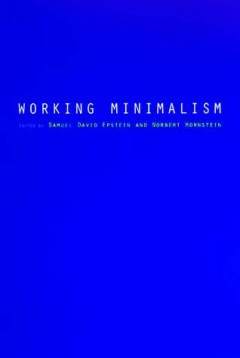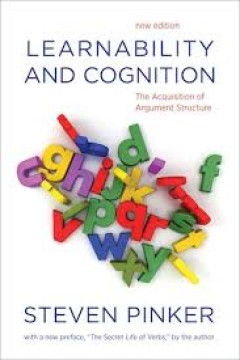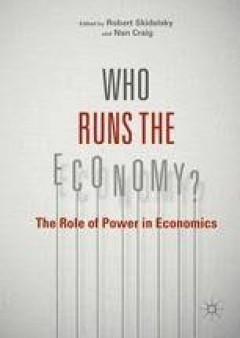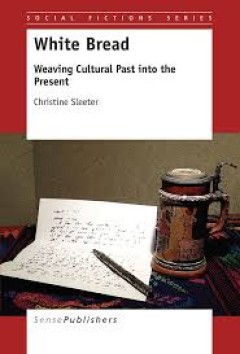Filter by

Working minimalism
AnnotationOCLC-licensed vendor bibliographic record.
- Edition
- -
- ISBN/ISSN
- 9780262272377
- Collation
- 1 online resource (371 pages).
- Series Title
- -
- Call Number
- -

Learnability and cognition : the acquisition of argument structure
Before Steven Pinker wrote bestsellers on language and human nature, he wrote several technical monographs on language acquisition that have become classics in cognitive science. Learnability and Cognition, first published in 1989, brought together two big topics: how do children learn their mother tongue, and how does the mind represent basic categories of meaning such as space, time, causalit…
- Edition
- New ed.
- ISBN/ISSN
- 9780262314275
- Collation
- 1 online resource (xx, 488 pages) :illustrations.
- Series Title
- -
- Call Number
- -

Who Runs the Economy? The Role of Power in Economics
Since the financial crisis of 2008 and the following Great Recession, there has been surprisingly little change in the systems of ideas, institutions and policies which preceded the crash and helped bring it about. 'Mainstream' economics carries on much as it did before. Despite much discussion of what went wrong, very little has substantially changed. Perhaps the answer has something to do wit…
- Edition
- -
- ISBN/ISSN
- 978-1-137-58017-7
- Collation
- -
- Series Title
- -
- Call Number
- -

White Bread Weaving Cultural Past into the Present
In White Bread, readers accompany Jessica on a journey into her family’s past, into herself, and into the bicultural community she teaches but does not understand. Jessica, a fictional White fifth-grade teacher, is prompted to explore her family history by the unexpected discovery of a hundred-year-old letter. Simultaneously, she begins to grapple with culture and racism, principally through …
- Edition
- -
- ISBN/ISSN
- 978-94-6300-067-3
- Collation
- -
- Series Title
- -
- Call Number
- -

What’s a Cellphilm? Integrating Mobile Phone Technology into Participatory…
What’s a Cellphilm? explores cellphone video production for its contributions to participatory visual research. There is a rich history of integrating participants’ videos into community-based research and activism. However, a reliance on camcorders and digital cameras has come under criticism for exacerbating unequal power relations between researchers and their collaborators. Using cellph…
- Edition
- -
- ISBN/ISSN
- 978-94-6300-573-9
- Collation
- -
- Series Title
- -
- Call Number
- -

What is Next in Educational Research?
What is Next in Educational Research? enables the reader to peek into research at the forefront of a diverse range of education fields as it is being conducted by beginning researchers. The book illustrates the extensive range of research being undertaken in education through a broad range of issues, topics and methodologies that will underpin and provoke research well into the future. The five…
- Edition
- -
- ISBN/ISSN
- 978-94-6300-524-1
- Collation
- -
- Series Title
- -
- Call Number
- -

What Every Woman Should Know about Cervical Cancer Revised and Updated
This book (an updated and extended edition) is about mobilizing women and health care policy makers and providers to unite their efforts in a single strategy for fighting cervical cancer worldwide. The objective of this strategy would be to reverse cervical cancer prevalence and mortality rates among all 2.4 billion women at risk and to achieve this goal within 10-15 years of implementation. Ce…
- Edition
- -
- ISBN/ISSN
- 978-94-017-7560-1
- Collation
- -
- Series Title
- -
- Call Number
- -

What Every Medical Writer Needs to Know Questions and Answers for the Seriou…
This book presents must-know facts generally not covered in “How To” books about medical writing. Every medical writer, whether a beginner or veteran, needs answers to questions many might not even know to ask. How does your personality type influence your writing behavior, and what can you do to make writing easier for you? What should you ask before agreeing to co-author an article for pu…
- Edition
- -
- ISBN/ISSN
- 978-3-319-20264-8
- Collation
- -
- Series Title
- -
- Call Number
- -

What Can PISA 2012 Data Tell Us? Performance and Challenges in Five Particip…
This is the first book regarding the issues of PISA that has been published with respect to the Southeast Asian region. It is hoped that the content of this book can benefit and provide greater understanding for readers of several important aspects: (a) country performance in PISA 2012 for each participating Southeast Asian country, (b) the need for international comparative studies from the pe…
- Edition
- -
- ISBN/ISSN
- 978-94-6300-468-8
- Collation
- -
- Series Title
- -
- Call Number
- -

The SAGES / ERAS® Society Manual of Enhanced Recovery Programs for Gastroint…
This volume presents a comprehensive, up to date and practical approach to creating an ERAS program for GI surgery. The first sections review the evidence underlying individual elements of ERAS, including evidence from laparoscopic procedures when available or pointing to evidence gaps where more research is required. These are written by experts in the field, including surgeons, anesthesiologi…
- Edition
- -
- ISBN/ISSN
- 978-3-319-20364-5
- Collation
- -
- Series Title
- -
- Call Number
- -
 Computer Science, Information & General Works
Computer Science, Information & General Works  Philosophy & Psychology
Philosophy & Psychology  Religion
Religion  Social Sciences
Social Sciences  Language
Language  Pure Science
Pure Science  Applied Sciences
Applied Sciences  Art & Recreation
Art & Recreation  Literature
Literature  History & Geography
History & Geography